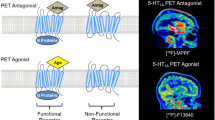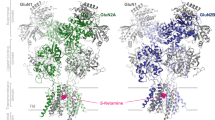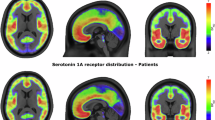Abstract
The serotonin 5-hydroxytryptamine-1A (5-HT1A) receptor subtype is of central interest in research, particularly in the area of pathophysiology and pharmacological treatment of psychiatric disorders. Robalzotan (generic name for NAD-299) is a new putative drug that binds with high selectivity and affinity to 5-HT1A-receptors in the rodent brain in vitro and in vivo. The aim of this positron emission tomography study was to determine 5-HT1A receptor occupancy in the cynomolgus monkey brain in vivo after IV injection of robalzotan. Two healthy monkeys were examined with Positron Emission Tomography (PET) and the radioligand [carbonyl-11C]WAY-100635, the first after IV administration of 2 μg/kg and 20 μg/kg, and the second after 10 μg/kg and 100 μg/kg IV. 5-HT1A receptor occupancy was calculated using an equilibrium-ratio analysis. Robalzotan occupied 5-HT1A receptors in a dose-dependent and saturable manner. The highest 5-HT1A receptor occupancy (70–80%) was attained after 100 μg/kg. The relationship between robalzotan drug concentration and 5-HT1A receptor occupancy could be described by a hyperbolic function, which can be used to guide the selection of appropriate doses for the initial studies in man. The study further corroborates that quantitative neuroimaging of receptor binding has potentials for the evaluation and dose finding of new CNS drugs.
Similar content being viewed by others
Log in or create a free account to read this content
Gain free access to this article, as well as selected content from this journal and more on nature.com
or
References
Andrée B, Thorberg S-O, Halldin C, Farde L . (1999): Pindolol binding to 5-HT1A receptors in the human brain confirmed with Positron Emission Tomography. Psychopharmacology 144: 303–305
Artigas F, Perez V, Alvarez E . (1994): Pindolol induces a rapid improvement of depressed patients treated with serotonin reuptake inhibitors. Arch Gen Psychiatry 51: 248–251
Baldwin D, Rudge S . (1995): The role of serotonin in depression and anxiety. Intl Clin Psychopharmacol 9: 41–45
Berendsen HH . (1995): Interactions between 5-hydroxy-tryptamine receptor subtypes: Is a disturbed receptor balance contributing to the symptomatology of depression in humans? Pharmacol Therap 66: 17–37
Berman RM, Darnell AM, Miller HL, Anand A, Charney DS . (1997): Effect of pindolol in hastening response to fluoxetine in the treatment of major depression: A double-blind, placebo-controlled trial. Am J Psychiatry 154: 37–43
Blier P, Bergeron R . (1995): Effectiveness of pindolol with selected antidepressant drugs in the treatment of major depression. J Clinical Psychopharmacol 15: 217–222
Burnet PW, Eastwood SL, Harrison PK . (1996): 5-HT1A and 5-HT2A receptor mRNAs and binding site densities are differentially altered in schizophrenia. Neuropsychopharmacology 15: 442–455
Farde L, Eriksson L, Blomquist G, Halldin C . (1989): Kinetic analysis of central [11C]raclopride binding to D2-dopamine receptors studied by PET—a comparison to the equilibrium analysis. J Cereb Blood Flow Metab 9: 696–708
Farde L, Gionvart N, Ito H, Lundkvist C, Pike VW, McCarron JA, Halldin C . (1997): PET-characterization of [carbonyl-11C]WAY-100635 binding to 5-HT1A receptors in the primate brain. Psychopharmacology 133: 196–202
Farde L, Hall H, Ehrin E, Sedvall G . (1986): Quantitative analysis of D2 dopamine receptor binding in the living human brain by PET. Science 231: 258–261
Farde L, Ito H, Swahn C-G, Pike VW, Halldin C . (1998): Quantitative analysis of [carbonyl-11C]WAY-100635 binding to central HT1A receptors in man. J Nucl Med 39: 1965–1971
Farde L, Nordström AL, Wiesel F-A, Pauli S, Halldin C, Sedvall G . (1992): Positron emission tomographic analysis of central D1 and D2 dopamine receptor occupancy in patients treated with classical neuroleptics and clozapine. Arch Gen Psychiatry 49: 538–544
Gagner Milchert I, Gabrielson J, Lindhe J, Terelius Y . (1998): In vitro- in vivo extrapolation of robalzotan metabolic parameters: An interspecies comparison. Eur Neuropsychopharmacol 8: 184
Gurevich EV, Joyce JN . (1997): Alterations in the cortical serotonergic system in schizophrenia: A postmortem study. Biol Psychiatry 42: 529–545
Hall H, Lundkvist C, Halldin C, Farde L, Pike VW, McCarron JA, Fletcher A, Cliffe IA, Barf T, Wilkstrom H, Sedvall G . (1997): Autoradiographic localization of 5-HT1A receptors in the post-mortem human brain using [3H[WAY-100625 and [11C]way-100635. Brain Res 745: 96–108
Hashimoto T, Kitamura N, Kajimoto Y, Shirai Y, Shirakawa O, Mita T, Nishino N, Tanaka C . (1993): Differential changes in serotonin 5-HT1A and 5-HT2 receptor binding in patients with chronic schizophrenia. Psychopharmacology 112: S35–S39
Hashimoto T, Nishino N, Nakai H, Tanaka C . (1991): Increase in serotonin 5-HT1A receptors in prefrontal and temporal cortices of brains from patients with chronic schizophrenia. Life Sci 48: 355–363
Hjorth S, Carlsson A . (1986): Is pindolol a mixed agonist-antagonist at central serotonin (5-HT) receptors? Eur J Pharmacol 129: 131–138
Hoyer D, Clarke DE, Fozard JR, Hartig PR, Martin GR, Mylecharane EJ, Saxena PR, Humphrey PP . (1994): International Union of Pharmacology classification of receptors for 5-hydroxytryptamine (Serotonin). Pharmacol Rev 46: 157–203
Ito H, Hietala J, Blomqvist G, Halldin C, Farde L . (1998): Comparison of the transient equilibrium and continuous infusion method for quantitative PET analysis of [11C]raclopride binding. J Cereb Blood Flow Metab 18: 941–950
Johansson L, Sohn D, Thornberg SO, Jackson DM, Kelder D, Larsson LG, Renyi L, Ross SB, Wallsten C, Eriksson H, Hu PS, Jerning E, Mohell N, Westlind-Danielson A . (1997): The pharmacological characterization of a novel selective 5-hydroxytryptamine1A receptor antagonist, NAD-299. J Pharmacol Exp Therap 283: 216–225
Joyce JN, Shane A, Lexow N, Winokur A, Casanova MF, Kleinman JE . (1993): Serotonin uptake sites and serotonin receptors are altered in the limbic system of schizophrenics. Neuropsychopharmacology 8: 315–336
Karlsson P, Farde L, Halldin C, Sedvall G, Skrumsager B, Foged C . (1993): [11C]NNC687 and [11C]NNC756 as radioligands for PET-determination of central D1-dopamine receptors. Psychopharmacology 113: 149–156
Karlsson P, Farde L, Halldin C, Sedvall G, Ynddal L, Sloth-Nielsen M . (1995a): Oral administration of NNC 756&—a placebo controlled PET study of D1-dopamine receptor occupancy and pharmacodynamics in man. Psychopharmacology 119: 1–8
Karlsson P, Farde L, Halldin C, Swahn C, Sedvall G . (1995b): Evaluation of [11C]SCH39166 as D1-dopamine receptor ligand for central D1 dopamine receptor binding and occupancy in man. Psychopharmacology 121: 309–316
Larsson LG, Stenfors C, Ross SB . (1998): Differential regional antagonism of 8-OH-DPAT-induced decrease in serotonin synthesis by two 5-HT1A receptor antagonists. Eur J Pharmacol 346: 209–215
Marazziti D, Marracci S, Palego L, Rotondo A, Mazzanti C, Nardi I, Ladinsky H, Giraldo E, Borsini F, Cassano GB . (1994): Localization and gene expression of serotonin 1A (5HT1A): Receptors in human brain postmortem. Brain Res 658: 55–59
McAskill R, Mir S, Taylor D . (1998): Pindolol augmentation of antidepressant therapy [published erratum appears in Br J Psychiatry 173:443, 1998]. Br J Psychiatry 173: 203–208
Moreno FA, Gelenberg AJ, Bachar K, Delgado PL . (1997): Pindolol augmentation of treatment-resistant depressed patients. J Clin Psychiatry 58: 437–439
Oksenberg D, Peroutka SJ . (1988): Antagonism of 5-hydroxytryptamine1A (5-HT1A): receptor-mediated modulation of adenylate cyclase activity by pindolol and propranolol isomers. Biochem Pharmacol 37: 3429–3433
Pazos A, Probst A, Palacios JM . (1987): Serotonin receptors in the human brain. III. Autoradiographic mapping of serotonin-1 receptors. Neuroscience 21: 97–122
Perez V, Gilaberte I, Faries D, Alvarez E, Artigas F . (1997): Randomised, double-blind, placebo-controlled trial of pindolol in combination with fluoxetine antidepressant treatment. Lancet 349: 1594–1597
Perez V, Soler J, Puigdemont D, Alvarez E, Artigas F . (1999): A double-blind, randomized, placebo-controlled trial of pindolol augmentation in depressive patients resistant to serotonin reuptake inhibitors. Grup de Recerca en Trastorms Afectius. Arch Gen Psychiatry 56: 375–379
Peroutka SJ, Howell TA . (1994): The molecular evolution of G protein-coupled receptors: Focus on 5-hydroxytryptamine receptors. Neuropharmacology 33: 319–324
Pike VW, McCarron JA, Lammertsma AA, Osman S, Hume SP, Sargent PA, Bench CJ, Cliffe IA, Fletcher A, Grasby PM . (1996): Exquisite delineation of 5-HT1A receptors in human brain with PET and [carbonyl-11C]WAY-100635. Eur J Pharmacol 301: R5–R7
Romero L, Celada P, Artigas F . (1994): Reduction of in vivo striatal 5-hydroxytryptamine release by 8-OH-DPAT after inactivation of Gi/G(o) proteins in dorsal raphe nucleus. Eur J Pharmacol 265: 103–106
Sandell J, Halldin C, Chou Y-W, Thornberg S-O, Sohn D, Werner T, Farde L . (1999a): Metabolic studies measured by HPLC in monkey plasma of the new 5-HT1A radioligand [C-11]NAD-299. J Labell Comp Radiopharm 42(Suppl 1):675–677
Sandell J, Halldin C, Hall H, Thorberg S-O, Werner T, Sohn D, Sedvall G, Farde L . (1999b): Radiosynthesis of autoradiographic evaluation of [11C]NAD-299, a radioligand for visualization of the 5-HT1A receptor. Nucl Med Biol 26: 159–164
Saxena PR . (1995): Serotonin receptors: Subtypes, functional responses and therapeutic relevance. Pharmacol Therap 66: 339–368
Stenfors C, Werner T, Ross SB . (1998): In vivo labelling of the mouse brain 5-hydroxytryptamine 1A receptor with the novel selective antagonist 3H-NAD-299. Naunyn-Schmiedebergs Arch Pharmacol 357: 500–507
Sumiyoshi T, Stockmeier CA, Overholser JC, Dilley GE, Meltzer HY . (1996): Serotonin 1A receptors are increased in postmortem prefrontal cortex in schizophrenia. Brain Res 708: 209–214
Tome MB, Isaac MT, Harte R, Holland C . (1997): Paroxetin and pindolol: A randomized trial of serotonergic autoreceptor blockade in the reduction of antidepressant latency. Intl Clin Psychopharmacol 12: 81–89
Wienhard K, Dahlbom M, Eriksson L, Michel C, Bruckbauer T, Pietrzyk U, Heiss W . (1994): The ECAT EXACT HR: Performance of a new high resolution position scanner. J Comp Ass Tomogr 18: 110–118
Zanardi R, Artigas F, Franchini L, Sforzini L, Gasperini M, Smeraldi E, Perez J . (1997): How long should pindolol be associated with paroxetine to improve the antidepressant response? J Clin Psychopharmacol 17: 446–450
Acknowledgements
The members of the PET group at Karolinska Institutet and collaborators at AstraZeneca AB are gratefully acknowledged. The study was supported by a grant from AstraZeneca AB, Södertälje and the Human Frontier Science Program Organization (HFSPO). RG0235/1998-B.
Author information
Authors and Affiliations
Rights and permissions
About this article
Cite this article
Farde, L., Andrée, B., Ginovart, N. et al. PET-Determination of Robalzotan (NAD-299) Induced 5-HT1A Receptor Occupancy in the Monkey Brain. Neuropsychopharmacol 22, 422–429 (2000). https://doi.org/10.1016/S0893-133X(99)00125-6
Received:
Revised:
Accepted:
Issue date:
DOI: https://doi.org/10.1016/S0893-133X(99)00125-6
Keywords
This article is cited by
-
Modeling of PET data in CNS drug discovery and development
Journal of Pharmacokinetics and Pharmacodynamics (2013)
-
Occupancy of dopamine D2 and D3 and serotonin 5-HT1A receptors by the novel antipsychotic drug candidate, cariprazine (RGH-188), in monkey brain measured using positron emission tomography
Psychopharmacology (2011)
-
Positron emission tomographic analysis of dose-dependent NAD-299 binding to 5-hydroxytryptamine-1A receptors in the human brain
Psychopharmacology (2003)



